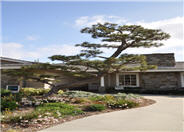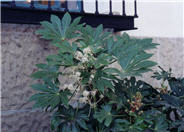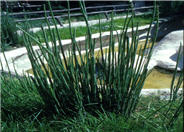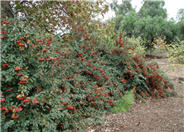
Common name:Japanese Black Pine
Botanical name:Pinus thunbergii
This variety of Pine is both rigid and twisted, with needles of 3"-4". It has an irregular shape, and the short, contorted branches produce a canopy shaped tree. The buds are white, and the cones are egg -shaped and without prickles. Pines are highly combustible plants.

Common name:Japanese Fatsia or Aralia
Botanical name:Fatsia japonica
This evergreen shrub has large, glossy, fan-like leaves that grow to 16" wide. It has a moderate growth rate to a size of 5'-8' that can be kept lower with occasional pruning. It has a very lush, tropical appearance, and grows well in partial shade.

Common name:Horsetail Reed
Botanical name:Equisetum hyemale
This reed-like plant bears dark green, jointed stems to 3'-4' tall. It should receive sun to part shade with regular summer watering. The reed grass can be extremely invasive and is best when used in pots or when confined by a barrier. As such, it can be extremely effective as an accent plant. While tolerant of wet conditions, the most successful plantings are those with average soil moisture. Tall grasses are highly combustible.

Common name:Red Clusterberry Cotoneaster
Botanical name:Cotoneaster lacteus
This is an evergreen shrub that grows to a size of 8' tall with long, arching branches. Cotoneaster exhibits dark green leaves above and gray beneath with dusky red fruit. It requires sun to part shade with little or no watering. This plant is tough enough to naturalize in many areas in CA, and should be considered potentially invasive.
| Designer: | Bamboo Water Pipe |
Photographer: GardenSoft |
Soils and Compost:
Incorporate compost 6" into your soil to retain water, reduce compaction, feed earthworms, and provide valuable nutrients to your plants.
Water Saving Tip:
Modify your controller each season. In the rainy season turn it off.
Integrated Pest Management:
Develop healthy soil for plants that are vigorous and naturally pest-resistant.

